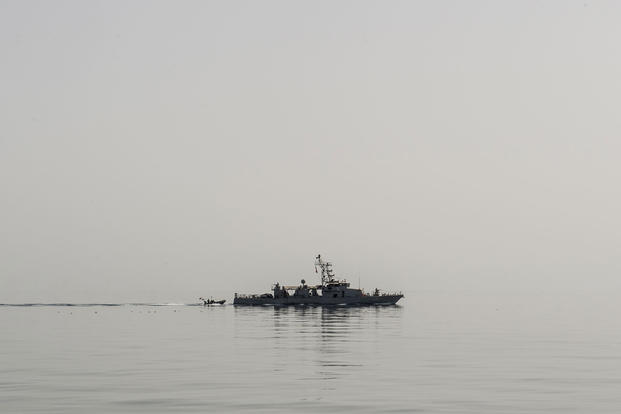A U.S. Navy Cyclone-class patrol ship was forced to fire warning shots from its .50-caliber machine gun Tuesday when a boat belonging to the Iranian Revolutionary Guard Corps Navy made an unsafe approach in the Arabian Gulf.
The USS Thunderbolt, a 174-foot patrol craft homeported in Bahrain, had been participating in a coalition exercise in international waters within the gulf when the Iranian vessel approached the Thunderbolt, a defense official told Military.com.
Related content:
- Navy Destroyer Fires Warning Shots at Iranian Vessels
- Amid Tense Encounters, US Ship Fires Warning Shots at Iranian Boats
- Equipment Guide: Cyclone-Class Coastal Patrol Ship
The Iranian vessel did not respond when bridge-to-bridge communication was initiated by the U.S. crew, the official said.
As the vessel continued to approach, the Thunderbolt initiated a series of warning measures, included warning flares and then five short blasts of a whistle, an internationally recognized danger sign. Despite these efforts, the Iranian vessel continued to come inbound, the official said.
Related Video:
Ultimately, the vessel came within 150 yards of the Thunderbolt. The crew fired warning shots, which finally stopped the craft.
A spokesman for U.S. Naval Forces Central Command, Lt. Ian McConnaughey, told Military.com that the shots were fired from one of the Thunderbolt's two .50-caliber machine guns and they were limited in number.
"The important takeaway is that the Thunderbolt went through an exhaustive series of radio hails, warnings (five short blasts) and fire flares prior to firing warning shots in front of the Iranian vessel," he said in an email.
Related Video:
![]()
Officials characterized the actions of the Iranian boat as "unsafe and unprofessional," and not in accordance with international norms for interaction at sea.
While the interaction occurred exclusively between the Thunderbolt and the Iranian vessel, there were a number of other U.S. ships in the vicinity during the encounter, McConnaughey said. They included the Ticonderoga-class cruiser Vella Gulf, the Coast Guard Island-class patrol boats Maui and Aquidneck, and an Army logistic support vessel, the James A. Loux.
Unsafe interactions between U.S. and Iranian vessels are far from uncommon. In late April, the guided-missile destroyer Mahan was forced to fire warning flares to halt the approach of an IRGCN vessel in what was the seventh such encounter of the year.
But while Navy officials in the past have provided tabulations of encounters to date, McConnaughey indicated they will no longer offer that information.
"While in the past we have discussed the number of interactions, even just one interaction like this is cause for concern," he said. "This type of behavior is not in accordance with international law and created an unnecessary risk of collision that could have led to potential miscalculation and escalation."
"Of note," he continued, "we actually had several other interactions with some smaller Iranian vessels following this one that were safe and professional. It is our desire to see more of that type of behavior going forward."
The Associated Press reported in April that there had been 35 unsafe and unprofessional encounters involving Iranian craft in 2016, and 23 the previous year.
-- Hope Hodge Seck can be reached at hope.seck@military.com. Follow her on Twitter at @HopeSeck.





























